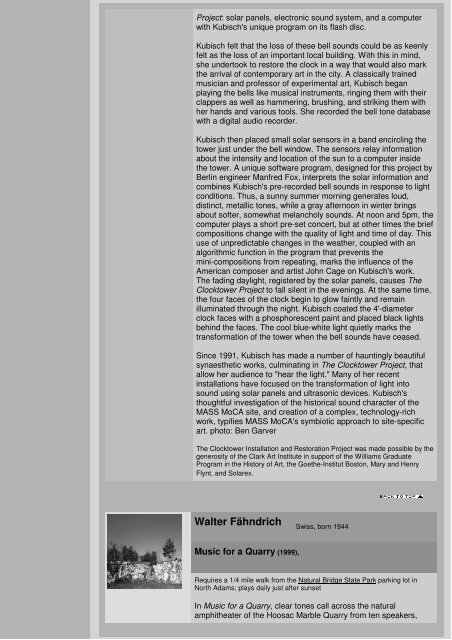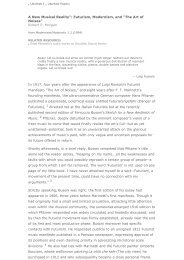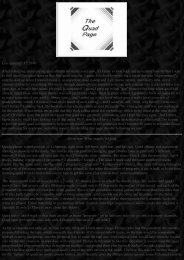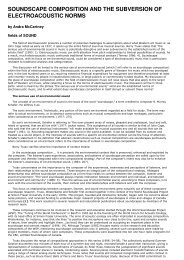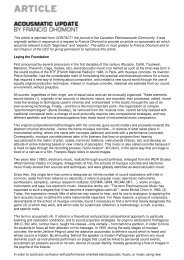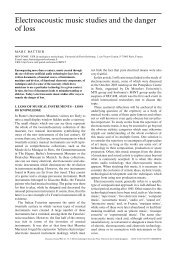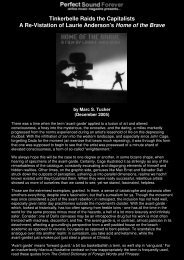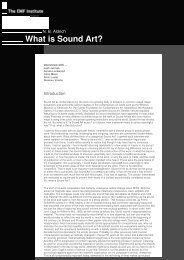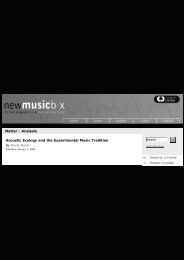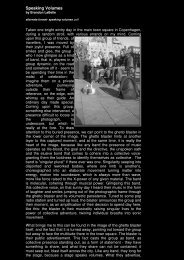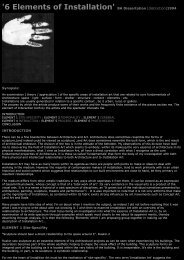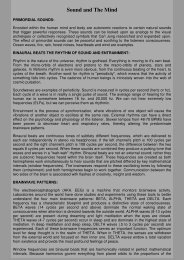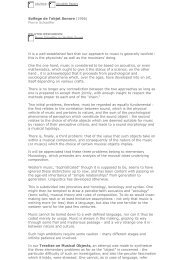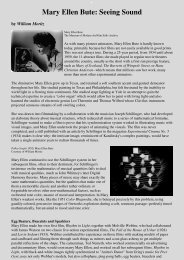MASS MoCA | Visual Arts | Sound Art - An International Archive of ...
MASS MoCA | Visual Arts | Sound Art - An International Archive of ...
MASS MoCA | Visual Arts | Sound Art - An International Archive of ...
Create successful ePaper yourself
Turn your PDF publications into a flip-book with our unique Google optimized e-Paper software.
Project: solar panels, electronic sound system, and a computer<br />
with Kubisch's unique program on its flash disc.<br />
Kubisch felt that the loss <strong>of</strong> these bell sounds could be as keenly<br />
felt as the loss <strong>of</strong> an important local building. With this in mind,<br />
she undertook to restore the clock in a way that would also mark<br />
the arrival <strong>of</strong> contemporary art in the city. A classically trained<br />
musician and pr<strong>of</strong>essor <strong>of</strong> experimental art, Kubisch began<br />
playing the bells like musical instruments, ringing them with their<br />
clappers as well as hammering, brushing, and striking them with<br />
her hands and various tools. She recorded the bell tone database<br />
with a digital audio recorder.<br />
Kubisch then placed small solar sensors in a band encircling the<br />
tower just under the bell window. The sensors relay information<br />
about the intensity and location <strong>of</strong> the sun to a computer inside<br />
the tower. A unique s<strong>of</strong>tware program, designed for this project by<br />
Berlin engineer Manfred Fox, interprets the solar information and<br />
combines Kubisch's pre-recorded bell sounds in response to light<br />
conditions. Thus, a sunny summer morning generates loud,<br />
distinct, metallic tones, while a gray afternoon in winter brings<br />
about s<strong>of</strong>ter, somewhat melancholy sounds. At noon and 5pm, the<br />
computer plays a short pre-set concert, but at other times the brief<br />
compositions change with the quality <strong>of</strong> light and time <strong>of</strong> day. This<br />
use <strong>of</strong> unpredictable changes in the weather, coupled with an<br />
algorithmic function in the program that prevents the<br />
mini-compositions from repeating, marks the influence <strong>of</strong> the<br />
American composer and artist John Cage on Kubisch's work.<br />
The fading daylight, registered by the solar panels, causes The<br />
Clocktower Project to fall silent in the evenings. At the same time,<br />
the four faces <strong>of</strong> the clock begin to glow faintly and remain<br />
illuminated through the night. Kubisch coated the 4'-diameter<br />
clock faces with a phosphorescent paint and placed black lights<br />
behind the faces. The cool blue-white light quietly marks the<br />
transformation <strong>of</strong> the tower when the bell sounds have ceased.<br />
Since 1991, Kubisch has made a number <strong>of</strong> hauntingly beautiful<br />
synaesthetic works, culminating in The Clocktower Project, that<br />
allow her audience to "hear the light." Many <strong>of</strong> her recent<br />
installations have focused on the transformation <strong>of</strong> light into<br />
sound using solar panels and ultrasonic devices. Kubisch's<br />
thoughtful investigation <strong>of</strong> the historical sound character <strong>of</strong> the<br />
<strong>MASS</strong> <strong>MoCA</strong> site, and creation <strong>of</strong> a complex, technology-rich<br />
work, typifies <strong>MASS</strong> <strong>MoCA</strong>'s symbiotic approach to site-specific<br />
art. photo: Ben Garver<br />
The Clocktower Installation and Restoration Project was made possible by the<br />
generosity <strong>of</strong> the Clark <strong>Art</strong> Institute in support <strong>of</strong> the Williams Graduate<br />
Program in the History <strong>of</strong> <strong>Art</strong>, the Goethe-Institut Boston, Mary and Henry<br />
Flynt, and Solarex.<br />
Walter Fähndrich<br />
Swiss, born 1944<br />
Music for a Quarry (1999),<br />
Requires a 1/4 mile walk from the Natural Bridge State Park parking lot in<br />
North Adams; plays daily just after sunset<br />
In Music for a Quarry, clear tones call across the natural<br />
amphitheater <strong>of</strong> the Hoosac Marble Quarry from ten speakers,


